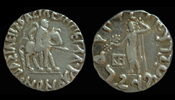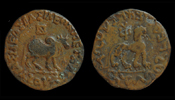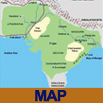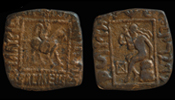|
|
The Indo Scythians, a branch of Sakas, were already present in the Indus Valley, even earlier than Achaeminids. The Yuezhi (Yueh- Chih), also known as �The Great Scythian Clan of Yue�, the Central Asian nomads pushed Sakas Southwards. Many different tribes grouped together under the Scythian or Scytho � Sarmatians, established their rule after Scythian conquering Indo-Greeks Kingdom. They became a strong ethnic group in the Indus Valley, Rajasthan, Gujrat, and upper Ganges Valley.
About 85 BC a Scythian Prince named Maues occupied Taxila, Gandhara. The Greeks were subsequently able to regain the lost territories of Punjab, another Scythian King Azes 1, dethroned the last Greek King to reign in Western Punjab, (including Taxila and Pushkalavati) expelled them in 55 BC. The overstrike coins give a very clear chronological picture of the Greek and Scythian Kings, who were successors of Maues in Taxila and Pushkalavati (South to Vonones). Gondophares, the founder of the Indo Parthian Kingdom, came to power towards the end of reign of Azes.
In about 10 AD the Scythian Rajuvula, the Satrap of Mathura (middle Ganges Valley), conquered last Greek bastion at Sagala (Sialkot) in eastern Punjab and thus the Greek power came to an end. The coinage of this period is much debased.
The coins of Indo-Scythians displayed Greek legends and Greek deities such as Zeus or Nike.
After the death of Azes, the rule of Indo Scythians in northwest India finally crumbled with the conquest of Indo Parthian ruler Gondophares, who established their Empire temporarily till 1st Century AD. which was replaced by Kushans, a tribe of Yuezhi, who lived in Bactria for more than a century, and came to India to create a Kushan Empire.
Indo-Scythians established a Kingdom by the coast in Abiria and Surastrene (Sindh and Gujrat) around 1st Century, moving northwards into Greek Kingdom and gained total control.
Sakas established several Kingdoms in India. One of them founded by Vonones, (northern Pakistan to Afghanistan and Baluchistan) who ruled with his brother Spalahores, after his death his son Spalarises ascended the throne.
The art of Indo-Greek coinage was not followed blindly by the Scythians, instead several new iconographic traits were introduced. The impact of steppe nomadic Scythian art, in which animal forms served as important motifs is seen. Scythian coins clearly depict the amalgamation of Hellenistic (Bactrian), Parthian (Iranian), nomadic (Scythian) and also Mathura School of Art. There is a brief discontinuity of representation of busts by Vonones and Azes Group. They adhered to Greek weight standard. The reverse of their coins represent numerous deities generally Hellenic occasionally Indian. The Greek and Kharoasthi legends are present.
The coins of Vonones are few, silver coins showing King on horseback on obverse and Zeus standing with a long Scepter and thunderbolt. On copper coins, Standing Herakles crowning himself on obverse and Pallas Athene on reverse. His joint issues with brother Spalagadama and his son Spalahora are available. After Vonones, Spalyris became ruler and issued joint coins with Spalagadama and Azes. All his coins have horse rider on the obverse and Zeus/Herakles on reverse. Indo-Scythian rulers are usually depicted on horse back in armor, but the coins of Azilises show the king in a simple, undecorated tunic.
|
|
|




